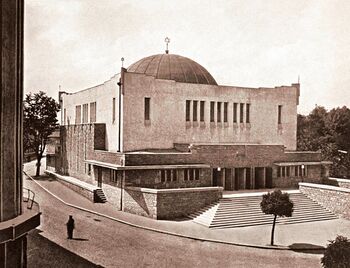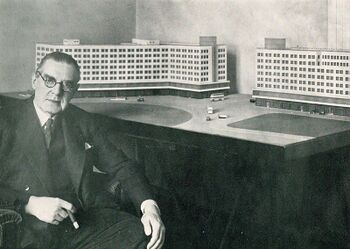Difference between revisions of "Peter Behrens"
m (Text replacement - "258px" to "350px") |
|||
| (4 intermediate revisions by the same user not shown) | |||
| Line 1: | Line 1: | ||
| − | [[Image:Peter_Behrens_in_his_Berlin_studio_c1928-29.jpg|thumb| | + | [[Image:Peter_Behrens_in_his_Berlin_studio_c1928-29.jpg|thumb|350px|Peter Behrens in his Berlin studio, c1928-29.]] |
| + | [[Image:Behrens_Peter_Zilina_Synagogue.jpg|thumb|350px|[http://www.novasynagoga.sk The Synagogue of Žilina], built 1928-31.]] | ||
'''Peter Behrens'''’ (1868–1940) artistic work encompasses all areas of applied art: book design and typography, painting and graphic reproduction, ceramic works such as tiles, pitchers and vases, furniture of all kinds and for every purpose, porcelain services, jewellery, silver and pewter articles such as cutlery and sets, wallpaper, textiles such as clothing, fabrics, carpets, table cloths, napkins and wall hangings, drinking glasses, carafes and glass vases, advertising art, posters and much more. Although he was a self-educated industrial designer, Peter Behrens was first and foremost an architect. During the first three decades of the 20th century, numerous villas, residential buildings, industrial facilities and worker housing estates were built according to his designs. Peter Behrens has influenced or played a decisive role in designing practically every area of life, the working world, its products and amenities. Like [[Henry van de Velde]], Peter Behrens was an »all-around« artist, too. After 1901, he established himself as one of the most important architects of modernism, leaving behind a rich legacy of industrial and administrative buildings, villas and entire housing estates. Behrens is also renowned for his role as mentor to [[Walter Gropius]], [[Ludwig Mies van der Rohe]], and even [[Le Corbusier]] for a time. [http://www.klassik-stiftung.de/en/exhibition-event/van-de-velde-2013/van-de-velde-2013/peter-behrens-from-jugendstil-to-industrial-design/ (Source)] | '''Peter Behrens'''’ (1868–1940) artistic work encompasses all areas of applied art: book design and typography, painting and graphic reproduction, ceramic works such as tiles, pitchers and vases, furniture of all kinds and for every purpose, porcelain services, jewellery, silver and pewter articles such as cutlery and sets, wallpaper, textiles such as clothing, fabrics, carpets, table cloths, napkins and wall hangings, drinking glasses, carafes and glass vases, advertising art, posters and much more. Although he was a self-educated industrial designer, Peter Behrens was first and foremost an architect. During the first three decades of the 20th century, numerous villas, residential buildings, industrial facilities and worker housing estates were built according to his designs. Peter Behrens has influenced or played a decisive role in designing practically every area of life, the working world, its products and amenities. Like [[Henry van de Velde]], Peter Behrens was an »all-around« artist, too. After 1901, he established himself as one of the most important architects of modernism, leaving behind a rich legacy of industrial and administrative buildings, villas and entire housing estates. Behrens is also renowned for his role as mentor to [[Walter Gropius]], [[Ludwig Mies van der Rohe]], and even [[Le Corbusier]] for a time. [http://www.klassik-stiftung.de/en/exhibition-event/van-de-velde-2013/van-de-velde-2013/peter-behrens-from-jugendstil-to-industrial-design/ (Source)] | ||
| Line 9: | Line 10: | ||
* Alan Windsor, ''Peter Behrens, Architect and Designer, 1868–1940'', London: Architectural Press, 1981. {{en}} | * Alan Windsor, ''Peter Behrens, Architect and Designer, 1868–1940'', London: Architectural Press, 1981. {{en}} | ||
** ''Peter Behrens. Architekt und Designer'', Stuttgart: Verlags-Anstalt, 1985. {{de}} | ** ''Peter Behrens. Architekt und Designer'', Stuttgart: Verlags-Anstalt, 1985. {{de}} | ||
| − | * Stanford Anderson, [http://web.mit.edu/soa/www/downloads/1990-99/MAeu_Per_26_1990_Theater_90.pdf "Peter Behrens's Highest ''Kultursymbol'', The Theater" | + | * Stanford Anderson, [http://web.mit.edu/soa/www/downloads/1990-99/MAeu_Per_26_1990_Theater_90.pdf "Peter Behrens's Highest ''Kultursymbol'', The Theater"], ''Perspecta'' 26 (1990), pp 103-134. {{en}} |
* ''Peter Behrens: Umbautes'', Licht Prestel, 1990. {{de}} | * ''Peter Behrens: Umbautes'', Licht Prestel, 1990. {{de}} | ||
* Kurt Asche (ed.), ''Die Quadratur des Kreises. Peter Behrens als Architekt und Designer'', Oldenburg, 1990. {{de}} | * Kurt Asche (ed.), ''Die Quadratur des Kreises. Peter Behrens als Architekt und Designer'', Oldenburg, 1990. {{de}} | ||
| Line 16: | Line 17: | ||
* Georg Krawietz, ''Peter Behrens im dritten Reich'', Weimar: VDG, 1995. {{de}} | * Georg Krawietz, ''Peter Behrens im dritten Reich'', Weimar: VDG, 1995. {{de}} | ||
* Ina Bahnschulte-Friebe, ''Künstlerkolonie Mathildenhöhe Darmstadt 1899–1914'', Darmstadt: Institut Mathildenhöhe, 1999. {{de}} | * Ina Bahnschulte-Friebe, ''Künstlerkolonie Mathildenhöhe Darmstadt 1899–1914'', Darmstadt: Institut Mathildenhöhe, 1999. {{de}} | ||
| − | * Kathleen James-Chakraborty, ''German Architecture for a Mass Audience, Routledge, 2000. {{en}} | + | * Kathleen James-Chakraborty, ''German Architecture for a Mass Audience'', Routledge, 2000. {{en}} |
| − | * Stanford Anderson, ''Peter Behrens and a New Architecture for the Twentieth Century'', MIT Press, 2002. [http://www.gbv.de/dms/bs/toc/306173158.pdf TOC]. {{en}} | + | * Stanford Anderson, ''Peter Behrens and a New Architecture for the Twentieth Century'', MIT Press, 2002. [http://www.gbv.de/dms/bs/toc/306173158.pdf TOC]. [http://mitpress.mit.edu/books/peter-behrens-and-new-architecture-twentieth-century] {{en}} |
| + | * Regine Broch, ''[http://archiv.ub.uni-marburg.de/diss/z2006/0065/pdf/ Peter Behrens' Wohnungsbaukonzepte, 1910-1920]'', Marburg: Philipps-Universitaet, 2005. Dissertation. {{de}} | ||
==Links== | ==Links== | ||
| + | * [http://www.novasynagoga.sk/ The Synagogue of Žilina], Slovakia, designed by Peter Behrens, built 1928-31. | ||
* [http://www.klassik-stiftung.de/en/exhibition-event/van-de-velde-2013/van-de-velde-2013/peter-behrens-from-jugendstil-to-industrial-design/ Peter Behrens. From Jugendstil to Industrial Design], exhibition, Kunsthalle Erfurt, 2013. | * [http://www.klassik-stiftung.de/en/exhibition-event/van-de-velde-2013/van-de-velde-2013/peter-behrens-from-jugendstil-to-industrial-design/ Peter Behrens. From Jugendstil to Industrial Design], exhibition, Kunsthalle Erfurt, 2013. | ||
* [http://de.wikipedia.org/wiki/Peter_Behrens Behrens at German Wikipedia] | * [http://de.wikipedia.org/wiki/Peter_Behrens Behrens at German Wikipedia] | ||
Latest revision as of 23:50, 25 May 2022

Peter Behrens’ (1868–1940) artistic work encompasses all areas of applied art: book design and typography, painting and graphic reproduction, ceramic works such as tiles, pitchers and vases, furniture of all kinds and for every purpose, porcelain services, jewellery, silver and pewter articles such as cutlery and sets, wallpaper, textiles such as clothing, fabrics, carpets, table cloths, napkins and wall hangings, drinking glasses, carafes and glass vases, advertising art, posters and much more. Although he was a self-educated industrial designer, Peter Behrens was first and foremost an architect. During the first three decades of the 20th century, numerous villas, residential buildings, industrial facilities and worker housing estates were built according to his designs. Peter Behrens has influenced or played a decisive role in designing practically every area of life, the working world, its products and amenities. Like Henry van de Velde, Peter Behrens was an »all-around« artist, too. After 1901, he established himself as one of the most important architects of modernism, leaving behind a rich legacy of industrial and administrative buildings, villas and entire housing estates. Behrens is also renowned for his role as mentor to Walter Gropius, Ludwig Mies van der Rohe, and even Le Corbusier for a time. (Source)
Writings[edit]
- Peter Behrens »Zeitloses und Zeitbewegtes« Aufsätze, Vorträge, Gespräche 1900-1938, eds. Hartmut Frank and Karin Lelonek, Dölling und Galitz, 2015. (German)
Literature[edit]
- Hans-Joachim Kadatz, Peter Behrens. Architekt, Maler, Grafiker und Formgestalter, Leipzig, 1977. (German)
- Alan Windsor, Peter Behrens, Architect and Designer, 1868–1940, London: Architectural Press, 1981. (English)
- Peter Behrens. Architekt und Designer, Stuttgart: Verlags-Anstalt, 1985. (German)
- Stanford Anderson, "Peter Behrens's Highest Kultursymbol, The Theater", Perspecta 26 (1990), pp 103-134. (English)
- Peter Behrens: Umbautes, Licht Prestel, 1990. (German)
- Kurt Asche (ed.), Die Quadratur des Kreises. Peter Behrens als Architekt und Designer, Oldenburg, 1990. (German)
- Hans-Georg Pfeifer, Peter Behrens. Wer aber will sagen, was Schönheit sei?, Düsseldorf: Beton, 1990. (German)
- Klaus J. Sembach, 1910 – Halbzeit der Moderne, Stuttgart: Hatje, 1992. (German)
- Georg Krawietz, Peter Behrens im dritten Reich, Weimar: VDG, 1995. (German)
- Ina Bahnschulte-Friebe, Künstlerkolonie Mathildenhöhe Darmstadt 1899–1914, Darmstadt: Institut Mathildenhöhe, 1999. (German)
- Kathleen James-Chakraborty, German Architecture for a Mass Audience, Routledge, 2000. (English)
- Stanford Anderson, Peter Behrens and a New Architecture for the Twentieth Century, MIT Press, 2002. TOC. [1] (English)
- Regine Broch, Peter Behrens' Wohnungsbaukonzepte, 1910-1920, Marburg: Philipps-Universitaet, 2005. Dissertation. (German)
Links[edit]
- The Synagogue of Žilina, Slovakia, designed by Peter Behrens, built 1928-31.
- Peter Behrens. From Jugendstil to Industrial Design, exhibition, Kunsthalle Erfurt, 2013.
- Behrens at German Wikipedia
